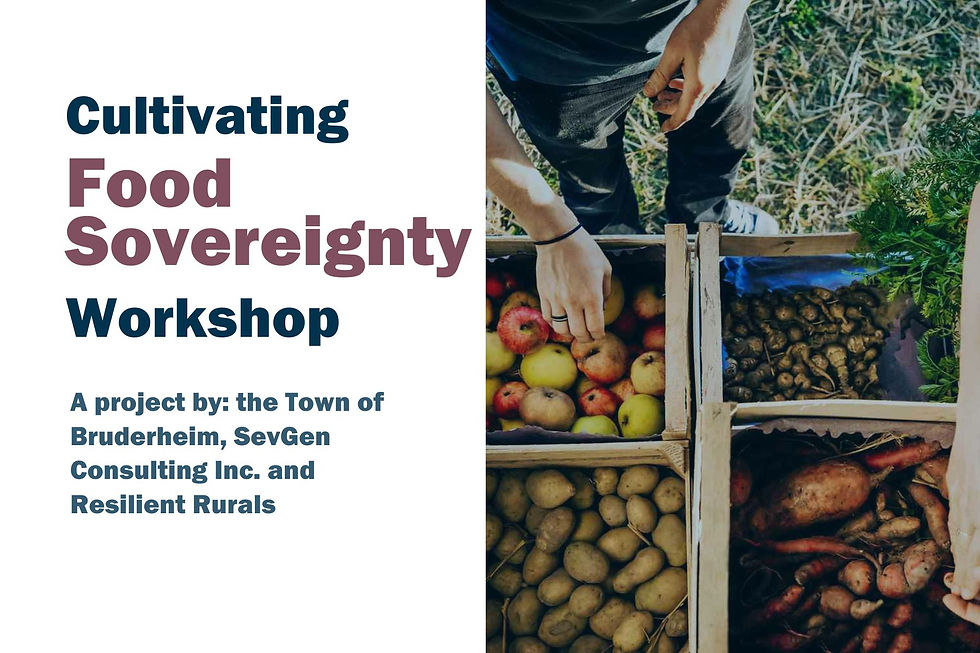Native Plant Tools to Support Nature-Based Solutions
- clairekroening
- Mar 30, 2023
- 3 min read
Resilient Rurals launches Climate-Smart Gardening resources for municipalities, greenhouses, and enthusiasts alike
Nature-based solutions (NBS) for climate adaptation and mitigation are becoming more popular and widely used among towns and cities across the world looking for a cost-effective way to adapt to changing climate conditions.
Projects of NBS design protect, sustainably manage and restore natural or modified ecosystems. Ecological restoration projects, green and natural infrastructures, and ecosystem-based disaster risk reduction are all strategies that fall under the umbrella of NBS.
Nature Canada makes the business case for NBS clear, saying these types of measures are a good economic decision for municipalities because they cost less to implement and maintain than traditional infrastructures, and are proactive adaptations that will save millions in the future in damage repairs and insurance. On top of long-term cost benefits, there are numerous bonus benefits to solutions that center nature like biodiversity enhancement, recreation and mental health benefits, and CO2 sequestration.
So what exactly does investment look like on the ground? It could look like a city committing to increasing its urban tree canopy coverage annually that will help reduce urban heat island effects. It could be a rural town setting aside land for planting native fruiting trees that attract pollinator species, like was done in Bruderheim, AB. It’s the large-scale wetland restoration projects underway on agricultural land, reintroducing natural flood protection and biodiversity to the area (check out ALUS Canada!).
Native plant species can play a pivotal role—even a starring role—in the effectiveness of NBS projects
If the land is available to be nurtured, restored, and rebalanced, there is major potential for NBS projects. In many cases, restoration and rebalancing involve a focus on using native plant species. For example, in the City of Edmonton’s naturalization initiatives and Root for Trees program, the species used are all native to the city’s river valley and ravine systems.
Ornamental trees and exotic shrubbery have their place in the beautification of many towns, cities, and acreages, but the real heavy hitters are those plants that are well-adapted to Alberta’s climate—which has traditionally been and will remain to be, a climate of extremes.
From the trees and plants lining your town’s streets and filling your local parks, to the flowers blooming right in your very own garden, well-adapted native species can thrive in drought conditions, soak up flood waters, and restore balance to the local ecosystem.
Introducing Native Roots—Native Alberta Plant Species Lists

To support Albertans in growing their knowledge of the benefits and uses of native plant species, Resilient Rurals has created two reference lists. The plants included in these lists represent species that grow naturally in Alberta and are either drought-tolerant and/or flood-resistant. Each list exclusively names plants that are already available for purchase from local growers and greenhouses and don’t include any plants that have been naturalized since European occupation, invasive or noxious species, or other non-native plants.
Download the Native Roots plant species lists
Discover more climate-smart gardening resources
Visit the Resilient Rurals Resource Hub for more information about sustainable gardening. Or learn from the experts about ecosystems, ecosystem services, and their role in climate adaptation and mitigation in the North Saskatchewan Watershed Alliance and Beaver Hills Biosphere Rural Showcase features.
With NBS and native plant species becoming more popular, suppliers should consider how to meet the market demand, as well as how to nurture it
We’ve heard from Bruderheim’s local greenhouse, Thiels Greenhouses, that more customers have been inquiring about native plant species. When exhibiting at the Green Industry Show & Conference this past fall, people’s faces lit up when they saw the words ‘native plants’ on our handouts. There is a real interest and emerging market for native varieties; as more municipalities and landowners undertake NBS and/or look to source native species, there is bound to be more demand for product as well as product knowledge.
Nurture the demand: What are we telling gardeners about climate-smart gardening?
Here are some of the key messages around native plants and their adaptive qualities that are important for everyone to know—from municipalities or organizations looking to procure a supplier to the gardening enthusiast coming into their local greenhouse:
The Alberta ‘climate of extremes’ is getting even weirder
The province has always seen multi-year drought periods followed by wet spells. We are no strangers to the variability of climate. However, we know from climate projections that our dry years are going to get dryer, and wet years will become even wetter as precipitation patterns change.
Plant for tougher growing conditions
Using references like Native Roots plant lists can help select the right drought-tolerant and flood-resistant plant species that will ensure gardens and landscapes grow healthy and beautiful all season long while providing ecological benefits.
Discover plant species native to Alberta
As weather patterns shift it's important to support the local ecosystems and take advantage of the adaptive capabilities of native plant species. So many of these species are pollinator-friendly and ecosystem-restoring while also being beautiful and eye-catching.
Shop local
More and more greenhouses and growers are supplying native Alberta plant species to garden and ecosystem restoration enthusiasts. Ask around—check out the supply at an old favourite or discover a new local go-to.
Looking for more on Nature Based Solutions in action?
.png)








Comments